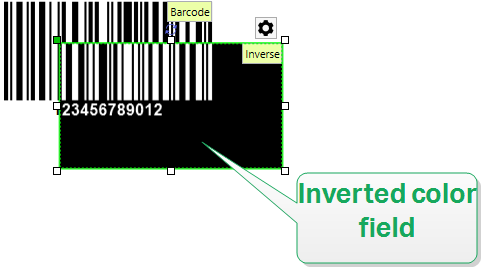Inverse
About
Inverse object inverts the underlying object's color.

Style
Style tab contains the Corner radius setting.
You can define the corner roundness of the Inverse object. Higher values make the curve broader.
Position
Position tab defines object positioning and its position-related behavior.
Position group defines the object's position.
X and Y: anchoring point coordinates.
Size group sets the object's dimensions:
Width and Height: horizontal and vertical object dimension.
Keep aspect ratio: simultaneous changing of object dimensions while scaling.
Note
If the measurement unit is changed in Label Properties, the value transforms automatically.
Rotation angle is the object angle according to the design surface.
Tip
There are multiple ways to set the object's angle: enter the angle manually, drag the slider or click and drag the 

Anchoring point is the spot where an object is pinned to design surface. Variable size objects increase or decrease their size in the direction that is opposite to the chosen anchoring point.
Lock prevents the object from being moved during the design process.
Relative Position options define the position of an object when label size or positions of neighboring objects are changing during the label design process.
Enable horizontal relative position: activates horizontal relative positioning.
Relative to label border: the position of object is defined relative to the reference label border. Define horizontal offset for the object with regard to this border.
Relative to another object: the position of object is defined relative to the border of a neighboring object. Define horizontal offset for the object with regard to this object.
Object: selects the reference object for horizontal relative positioning.
Border: neighboring object's reference border or label border (if there are no other objects on the label) for horizontal relative positioning.
Offset: horizontal distance from label border or reference object's anchoring point.
Enable vertical relative position: activates vertical relative positioning.
Relative to label border: the position of object is defined relative to the reference label border. Define vertical offset for the object with regard to this border.
Relative to another object: the position of object is defined relative to the border of a neighboring object. Define vertical offset for the object with regard to this object.
Object: selects the reference object for vertical relative positioning.
Border: neighboring object's reference border or label border (if there are no other objects on the label) for vertical relative positioning.
Offset: vertical distance from label border or reference object's anchoring point.
Note
Object position changes if label size or position of the related object change.
When designing double-sided labels, you can also take objects on the opposite side of the label as reference objects for relative positioning. In this case, objects on opposite sides move together if you change their positions.
Note
Label sides of reference objects are clearly identified on the Object selection list with (Front Side) and (Back Side).
Note
If the measurement unit is changed, the value transforms automatically.
General
General tab identifies the object and sets its status.
Name sets a unique object ID.
Note
Avoid using spaces or special characters in object names.
Description allows adding notes and annotations for an object. It provides help during the label design process.
Status group defines object visibility on print preview and on printed labels.
Not printable: prevents the object from being printed. The object still remains visible on the print preview and affects other objects in relative positioning. This option is useful when printing on predesigned or stock-specific labels.
Visible: if the checkbox is not selected, the object neither appears on the print preview nor on the printed label. The object is treated as if it does not exist.
Condition: makes an object enabled (editable) if the result of the given condition is "True".
This setting defines object visibility on form startup and when the connected variable's value changes. Tip
Equals (=) and slashed equals (≠) signs are allowed to be used in object visibility condition. Click the Equal/Not equal button select the appropriate sign type.
Not printable (selected) | YES | NO | YES |
Visible (cleared) | NO | NO | NO |
Printing optimization group allows activating the use of internal printer elements.
Tip
If supported by the selected printer model, a share of label element processing is handled directly by the printer (e.g., internal fonts, shapes, barcodes). This speeds up the printing process also due to significantly reduced data traffic.
Use printer element if supported: prints labels using internal printer elements if the printer allows it. If a selected printer does not support internal printer elements, the element is sent as a graphic file.
Always use printer element: prints labels using printer elements only. If a selected printer does not support internal printer elements, an error message with the explanation is displayed.
Always print as graphics: sends and prints the objects as graphic files.
Note
Inverse object can only be printed as graphics if the advanced printer driver interface is disabled. Make sure Windows Printing Mode is on before printing. Double-click the design surface to open Label Properties dialog and go to Printer panel > Printing > disable option Use advanced printer driver interface.